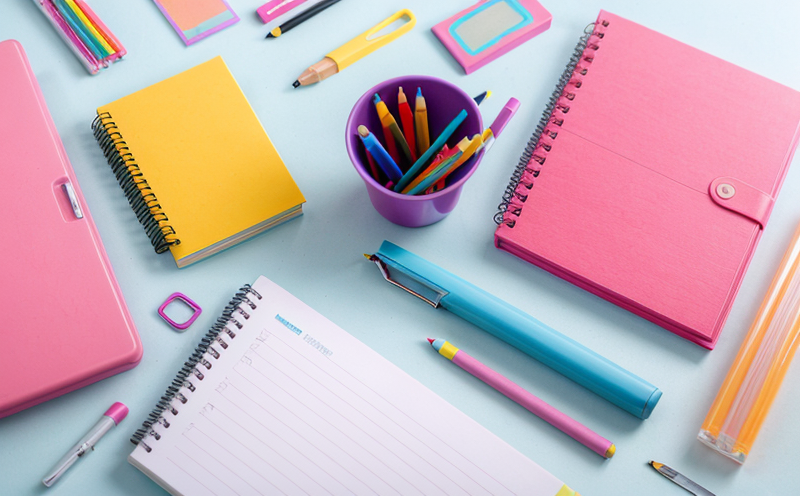Erasability Testing of Pencils and Pens
The erasability testing of pencils and pens is a critical component in ensuring consumer product safety and quality. This testing process evaluates the effectiveness with which the lead or ink can be removed from various surfaces, such as paper, using standard erasers. This service is particularly important for manufacturers of stationery and school supplies, where customer satisfaction and compliance with international standards are paramount.
Consumer products, especially those aimed at children, must meet stringent safety requirements to prevent any potential harm. Erasability testing helps in identifying any risks associated with the material used in pencils and pens that might not be easily erased, potentially leading to smudging or transfer of color onto other surfaces. This can cause discomfort for users and may even lead to accidents if the transferred material is ingested by children.
The testing process involves several steps. Firstly, samples of pencils and pens are prepared according to specific standards such as ASTM D5264-17. The specimens are then placed on a standard type of paper under controlled conditions that mimic real-world usage scenarios. After writing or coloring with the specimen, erasers compliant with ISO 3890:2021 are used to attempt removal of the lead or ink from the surface.
The effectiveness of the eraser in removing the material is then assessed visually and by measuring any remaining residue using appropriate analytical techniques. The results are compared against predefined acceptance criteria, which vary depending on the type of product being tested. For example, for pencils aimed at younger children, a higher degree of erasability may be required to ensure safety.
The importance of this service cannot be overstated. Manufacturers rely on accurate and reliable testing to meet regulatory requirements and maintain brand reputation. By ensuring that their products pass erasability tests, manufacturers can demonstrate compliance with international standards such as ISO 8256:2019 for toy safety and ASTM D4236-17 for consumer product labeling.
Real-world applications of this service include the development of new pencil and pen models. Manufacturers often conduct erasability testing during the early stages of product design to identify any potential issues with material selection or formulation. This proactive approach ensures that any defects are addressed before mass production, saving time and resources in the long run.
Furthermore, consumer feedback is a crucial factor in improving product quality. By using this service, manufacturers can gather data on user satisfaction and make informed decisions to enhance their products. For instance, if customers report difficulty in erasing certain pencil leads or ink from paper, manufacturers can modify the formulation to improve erasability.
Benefits
- Enhanced Consumer Safety: Ensures that products are safe for use and do not pose a risk of ingestion or injury.
- Improved Quality Control: Identifies any flaws in the manufacturing process early on, leading to higher quality output.
- Compliance with Standards: Helps manufacturers meet stringent international standards, thereby reducing the risk of product recalls.
- Informed Decision-Making: Provides valuable insights for R&D and procurement teams to make informed decisions about material selection and formulation.
- Increased Customer Satisfaction: By meeting erasability standards, manufacturers can ensure that their products meet customer expectations and enhance brand loyalty.
- Competitive Advantage: Superior erasability performance can be a key differentiator in the marketplace, attracting more customers to choose your product over competitors.
Customer Impact and Satisfaction
The impact of erasability testing extends far beyond just ensuring safety; it also significantly enhances customer satisfaction. When consumers can easily erase mistakes without leaving residual marks, they are more likely to be satisfied with the product. This not only improves brand reputation but also fosters positive word-of-mouth recommendations.
Customers appreciate products that meet or exceed their expectations. By offering pencils and pens that have excellent erasability characteristics, manufacturers can build trust and loyalty among their customer base. In turn, this leads to repeat purchases and a stronger market presence.
- Increased Efficiency: Easy-to-erase pencil marks allow for faster corrections without wasting time on smudging or re-writing.
- Enhanced User Experience: A better user experience translates directly into higher customer satisfaction, which is crucial in the competitive stationery market.
In conclusion, erasability testing plays a vital role in enhancing both consumer safety and satisfaction. By adhering to international standards and conducting thorough testing, manufacturers can produce high-quality products that meet or exceed customer expectations.
International Acceptance and Recognition
Erasability testing is widely recognized and accepted across the globe due to its importance in consumer product safety. International standards such as ISO 8256:2019 for toy safety, ASTM D4236-17 for consumer product labeling, and ASTM D5264-17 provide clear guidelines on how products should be tested.
Manufacturers who adhere to these standards can ensure that their products meet the highest quality benchmarks. This not only enhances the credibility of the manufacturer but also opens up new markets as consumers trust brands that comply with international regulations.
- Broad Market Reach: Compliance with international standards allows manufacturers to sell their products in multiple countries without facing regulatory barriers.
- Positive Reputation: Meeting these standards reflects well on the company, leading to increased market share and customer trust.
The acceptance of erasability testing is also reflected in its inclusion in many certification programs. For instance, products that pass this test can be awarded certifications like the CE Mark, which is essential for selling products within the European Union.
By ensuring that their stationery and school supplies meet stringent erasability standards, manufacturers demonstrate a commitment to quality and safety. This not only enhances their reputation but also ensures that they are at the forefront of industry best practices.





